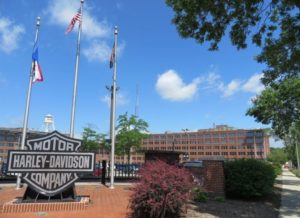Harley-Davidson saw worldwide sales of its motorcycles improve in the first quarter of 2016, but the company’s profit was down 7 percent as it increased investments in marketing and its Kansas City manufacturing facility.

The Milwaukee-based motorcycle maker reported net income of $250.5 million, down from $269.9 million last year. The company had diluted earnings per share of $1.36, up from $1.27 with a reduction in outstanding shares.
The company reported 57,458 motorcycles sold worldwide, an increase of 1.4 percent. The figure was driven by increases in Asia Pacific, which had its best first quarter ever; the Europe, Middle East and Africa region; and Canada. Sales in the United States were down slightly to 35,326 and Latin America figures were held back by weakness in Brazil.
Sales were down .5 percent in the U.S., but chief financial officer John Olin said weakness in oil dependent areas pulled sales down by 1.5 percentage points, meaning sales could have been up if oil and gas markets were performing better.
Company executives were optimistic about the U.S. sales figures as they showed improvement from recent quarters. The company was also able to stabilize its market share, which was down slightly to 50.9 percent for new retail sales of 601 cc and up motorcycles. In the first quarter of 2015, the company lost 4.7 percentage points of share because of increased competitiveness.
Revenue for Harley’s motorcycle segment was up 4.4 percent to $1.58 billion. Financial services revenue was up 6.7 percent to $173.4 million.
The company’s gross margin was down from 39.1 percent of revenue to 37.4 percent. The drop was driven by sales of lower margin motorcycles, foreign currency weakness and the implementation of a new enterprise resource planning system at the company’s Kansas City facility.
Sales, general and administrative expenses also increased $13 million, in part driven by increased marketing efforts.
Harley has undertaken a number of steps in recent months to counteract increased competitiveness brought by Polaris Industries’ relaunch of the Indian Motorcycle brand. That includes $70 million of increased spending on marketing in an effort to increase demand.
Chief executive officer Matt Levatich said the first quarter results demonstrates the initial success that Harley’s efforts are having and said the company embraces the increased competition because “it drives us to be better than we’ve ever been.”
“We don’t expect the current environment to change,” Levatich said. “In fact, we view it as the new normal.”
The company’s initiatives have included the launch of the “Live Your Legend” campaign, an increased presence at major events like South by Southwest, X Games and Daytona Bike Week, and increased demo and riding academy opportunities.

Levatich said dealerships had trained 8,000 people since the start of the year, a 37 percent increase driven by offering the service for free to active duty and retired military personnel and first responders.
He also said the company is selling more motorcycles to today’s young adults than were sold to the Baby Boomer generation when they were young and one-third of Harley buyers are new to the company and new to motorcycles.
Levatich said international sales were a bright spot in the quarter and the company is continuing with plans to increase dealer access. The goal is to add up to 200 new international dealerships by 2020. A total of five dealerships were added in the first quarter in Belgium, Brazil, Hong Kong, India and the Philippines.
Harley has also launched three new models this year, including one on Monday. Levatich said in the long-run the company is looking for new products to meet demand from its traditional customers, international markets and its outreach efforts, but said in the short-run they help create buzz about the company and its brand.


